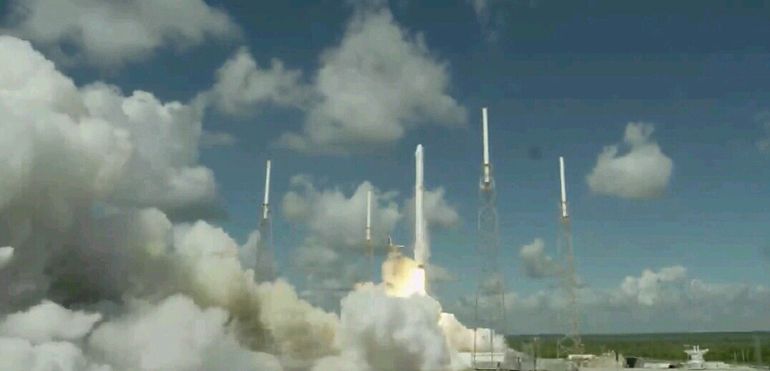In yet another massive setback for Elon Musk’s SpaceX, its resupply mission to the International Space Station ended in disaster yesterday as its CRS-7 rocket exploded in midair shortly after liftoff. The unmanned Dragon cargo ship atop a Falcon 9 rocket launched from Launch Complex 40 at Cape Canaveral Air Force Station at 10:21 am EDT. SpaceX launch control indicated no problems prior to launch and weather was good, but approximately 2 min 18 sec into the flight, the Falcon 9 experienced an anomaly and broke up over the Atlantic Ocean. Approximately twenty seconds before that, SpaceX had lost communications with Falcon, the first sign that something was remiss.
This is a huge blow to SpaceX, which has successfully launched six resupply missions to the ISS before CRS-7 as part of a $2bn+ contract with NASA. In fact, the resupply component wasn’t being seen as the challenging part of the mission. Instead, all eyes were on whether SpaceX could return the rocket to Earth on a floating landing pad, its third attempt at the all-important reuse phase which will help make the company’s missions more affordable in future.
First flown in December 2010, SpaceX’s Dragon became the first commercial spacecraft to visit the International Space Station when it berthed during its second and final COTS test flight, C2+, in May 2012. In October 2012 the first operational CRS mission was conducted and since then Dragon has made regular visits to the ISS. Its most recent mission, CRS-6, launched in April and successfully concluded its mission five weeks later with splashdown in the Pacific Ocean. Dragon is the only recoverable vehicle used for unmanned resupply missions to the space station, allowing it to return larger items of cargo from orbit to Earth.
The cause of the incident is still under investigation, with range safety officers evaluating available data according to a statement from the US Air Force 45th Space Wing. A tweet from Musk suggests there was “an overpressure event in the upper stage liquid oxygen tank.”
That’s all we can say with confidence right now. Will have more to say following a thorough fault tree analysis.
— Elon Musk (@elonmusk) June 28, 2015
A Microsoft HoloLens augmented-reality headset was also destroyed in the explosion, on its way up into orbit. Though not a cause for immediate concern, the loss of this cargo is worrying because it is the third resupply mission to the ISS to fail in less than a year, following the previous Antares launch vehicle explosion and the failure of the Russian Progress 59 cargo ship to respond to commands after lift off. CRS-7 was expected to make up for some of these losses, but today’s events once again raise the question of the station’s future, which could see it operating with a reduced crew or, in a worst case scenario, abandoned altogether. Despite it, NASA insists that the astronauts already on the ISS are in no danger of running low on food or water. “The commercial cargo program was designed to accommodate loss of cargo vehicles,” NASA Administrator Charles Bolden said of the incident. “We will continue operation of the station in a safe and effective way as we continue to use it as our test bed for preparing for longer duration missions farther into the solar system.” Meanwhile, ISS Astronaut Scott Kelly posted the following to Twitter after the failed launch.
Watched #Dragon launch from @space_station Sadly failed Space is hard Teams assess below @NASAKennedy #YearInSpace pic.twitter.com/myi3col5Ix — Scott Kelly (@StationCDRKelly) June 28, 2015

